April the 15th: In the United States, it’s a date dreaded by many, as the date to file taxes – or beg for an extension – looms large. But this year, Tax Day gives lovers of the sky something to look forward to, as the first of four total lunar eclipses for 2014 and 2015 occurs on the night of April 14th/15th favoring North and South America.

This marks the first total lunar eclipse visible from since December 10th 2011, which was visible at moonset from North America, and marks the start of the first of two eclipse seasons for 2014. Totality will last 1 hour, 17 minutes and 48 seconds, and will be visible in its entirety from the central Atlantic westward to eastern Australia. Unlike a total solar eclipse, which occurs along a narrow track, a total lunar eclipse can be viewed by the entire moonward facing hemisphere of the Earth.
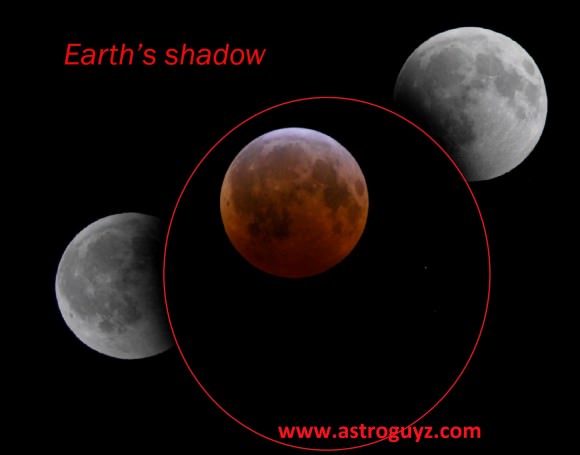
The action begins at 4:37 Universal Time (UT)/12:37 AM EDT, when the Moon enters the western edge of the Earth’s shadow known as the penumbra. The Moon will be completely immersed in the penumbra by 5:58 UT/1:58 AM EDT, but don’t expect to see anything more than a faint tan shading that’s slightly darker on the Moon’s northeastern edge.
The real action begins moments later, as the Moon encounters the ragged edge of the umbra, or the inner core of the Earth’s shadow. When does the umbra first become apparent to you? Totality then begins at 7:06 UT/3:06 AM EDT and lasts until 8:24 UT/4:24 AM EDT, with mid-eclipse occurring just south of the center of the Earth’s shadow at 7:46 UT/3:46 AM EDT.
Finally, the eclipse ends as the Moon slides out of the penumbra at 10:37 UT/ 6:37 AM EDT. Michael Zeiler (@EclipseMaps) has complied a fine video guide to the eclipse:
Field guide to the total lunar eclipse of April 14 – 15, 2014 from Michael Zeiler on Vimeo.
This eclipse is also notable for being part of a series of four lunar eclipses in 2014 & 2015, known as a “tetrad.” NASA eclipse expert Fred Espenak notes that this series of eclipses is also notable in that all four are visible in part or in their entirety from the United States. We’re in a cycle of 9 sets of tetrads for the 21st century, which began with the first set in 2003. Before that, you have to go all the way back to the 16th century for the last set of eclipse tetrads!
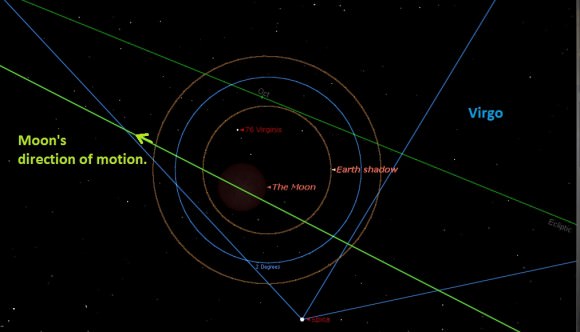
For saros buffs, the April 15th eclipse is Member 56 of 75 of saros 122, which began on August 14th 1022 A.D. and runs out until a final penumbral eclipse of the series on October 29th, 2338. There are only two total eclipses left in this particular saros, one in 2032 and 2050. If you caught the total lunar eclipse of April 4th, 1996, you saw the last lunar eclipse in this same saros series.
Lunar eclipses have turned up at some curious junctures in history. For example, a lunar eclipse preceded the fall of Constantinople in 1453. A 2004 lunar eclipse also fell on the night that the Red Sox won the World Series after an 86 year losing streak, though of course, lunar eclipses kept on occurring during those losing years as well. Christopher Columbus was known to evoke an eclipse on occasion to get him and his crew out of a jam, and also attempted to use a lunar eclipse to gauge his position at sea using a method first described by Ptolemy while studying the lunar eclipse of September 20th, 331 B.C.
A handful of stars in the +8th to +12th magnitude range will be occulted by the eclipsed Moon as well. Brad Timerson of the International Occultation Timing Association (IOTA) has put together a list, along with graze line prospects across the United States. The brightest star to be occulted by the eclipsed Moon is +5th magnitude 76 Virginis across western South America and Hawaii:
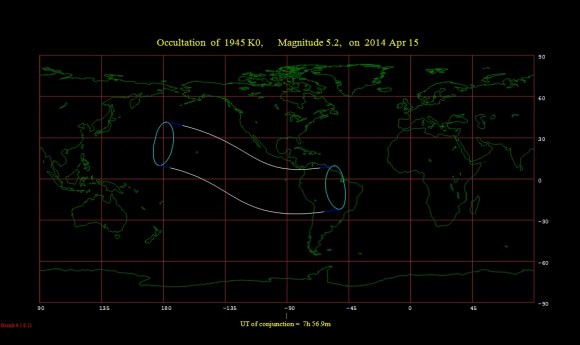
Note that the bright star Spica will be only just over a degree from the eclipsed Moon, and Mars will also be nearby, just a week past its 2014 opposition. And to top it off, Saturn is just one constellation to the east in Libra!
During the partial phases of the eclipse, watch for the Moon to take on a “Pacman-like” appearance. The Earth’s umbra is just under three times the size of the Moon, and the Greek astronomer Aristarchus of Samos used this fact and a little geometry to gauge the distance to our natural satellite in the 3rd century B.C.
As totality approaches, expect the innermost rim of the Moon to take on a ruddy hue. This is the famous “combination of all the sunrises and sunsets” currently underway worldwide as light is bent through the Earth’s atmosphere into its shadow. It’s happening every night, and during the totality of a lunar eclipse is the only chance that we get to see it.
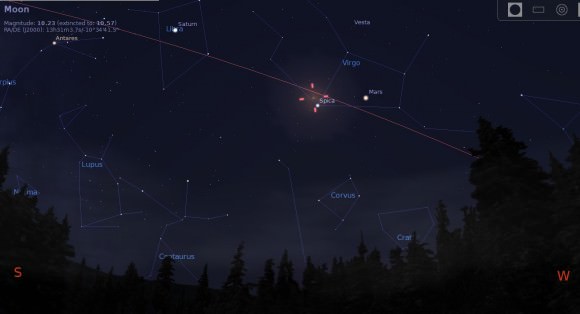
You don’t need anything more sophisticated than the naked eye or “Mark 1 eyeball” to enjoy a lunar eclipse, though it’s fun to watch through binoculars or a low-power telescope field of view. One interesting project that has been ongoing is to conduct timings for the moment when the umbra contacts various craters on the Moon. It’s a curious mystery that the Earth’s shadow varies by a small (1%) but perceptible amount from one eclipse to the next, and efforts by amateur observers may go a long way towards solving this riddle.
Said color of the fully eclipsed Moon can vary considerably as well: the Danjon scale describes the appearance of the eclipsed Moon, from bright and coppery red (Danjon 4) to so dark as to almost be invisible (Danjon 0). This is a product of the amount of dust, volcanic ash and aerosols currently aloft in the Earth’s atmosphere. During the lunar eclipse of December 9th, 1992 the Moon nearly disappeared all together, due largely to the eruption of Mount Pinatubo the year prior.
A lunar eclipse also presents a chance to nab what’s known as a Selenelion. This occurs when the Sun and the totally eclipsed Moon appear above the local horizon at the same time. This is possible mainly because the Earth’s shadow is larger than the Moon, allowing it to linger a bit inside the umbra after sunrise or before sunset. Gaining some altitude is key to making this unusual observation. During the April 15th eclipse, selenelion sightings favor the Mid-Atlantic and Greenland where totality is underway at sunrise and eastern Australia, where the reverse is true at sunset.
Want to have a go at measuring the brightness or magnitude of the eclipsed Moon? Here’s a bizarre but fun way to do it: take a pair of binoculars and compare the pinpoint Moon during totality to the magnitude of a known star, such as Antares or Spica.
Note that to do this, you’ll first need to gauge the magnitude extinction of your particular binoculars: NASA’s got a table for that, or you could field test the method days prior on Venus, currently shining at a brilliant -4.2 in the dawn. Hey, what’s a $1,000 pair of image-stabilized binocs for?
And of course, weather prospects are the big question mark for the event. Mid-April weather for North America is notoriously fickle. We’ll be watching the Clear Sky Chart and Skippy Sky for prospects days before the eclipse.
Photography during an eclipse is fun and easy to do, and you’ll have the waxing gibbous Moon available to practice on days prior to event. Keep in mind, you’ll need to slow down those shutter speeds as the Moon enters into totality, we’re talking going down from 1/60th of a second down to ¼” pretty quickly. In the event of a truly dark eclipse, the Moon may vanish in the view finder all together. Don’t be afraid to step exposures up to the 1 to 4 second range in this instance, as you’ve got over an hour to experiment.
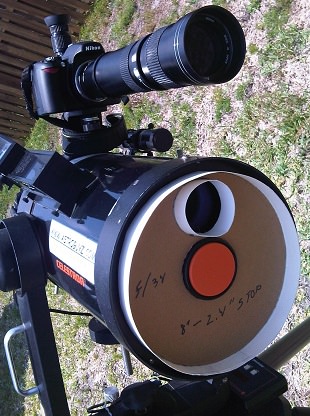
Thus far, only one webcast for the eclipse has surfaced, courtesy of the venerable Slooh. We’ll most likely be doing a follow up roundup of eclipse webcasts as they present themselves, as well as a look at prospects for things like a transit of the ISS in front of the eclipsed Moon and weather forecasts closer to show time.
And speaking of spacecraft, China’s Chang’e 3 lander and Yutu rover will have a fine view of a solar eclipse overhead from their Mare Imbrium vantage point, as will NASA’s LRO and LADEE orbiters overhead. In fact, NASA hinted last year that the April 15th eclipse might spell the end of LADEE entirely…
And thus marks the start of eclipse season one of two for 2014. Next up will be a curious non-central annular solar eclipse over Antarctica on April 29th, followed by another total lunar eclipse on October 8th, and a fourth and final partial solar eclipse of the year for North America of October 23rd.
Watch this space and follow us on Twitter as @Astroguyz, as we’ll be “all eclipses, all the time,” for April… no new taxes guaranteed!
Next up: Heard the one about the Blood Moon? Yeah, us too… join us as we debunk the latest lunacy surrounding the eclipse tetrad!
– Got pics of the lunar eclipse? Send ‘em in to Universe Today, as a post-eclipse photo round up is a very real possibility!

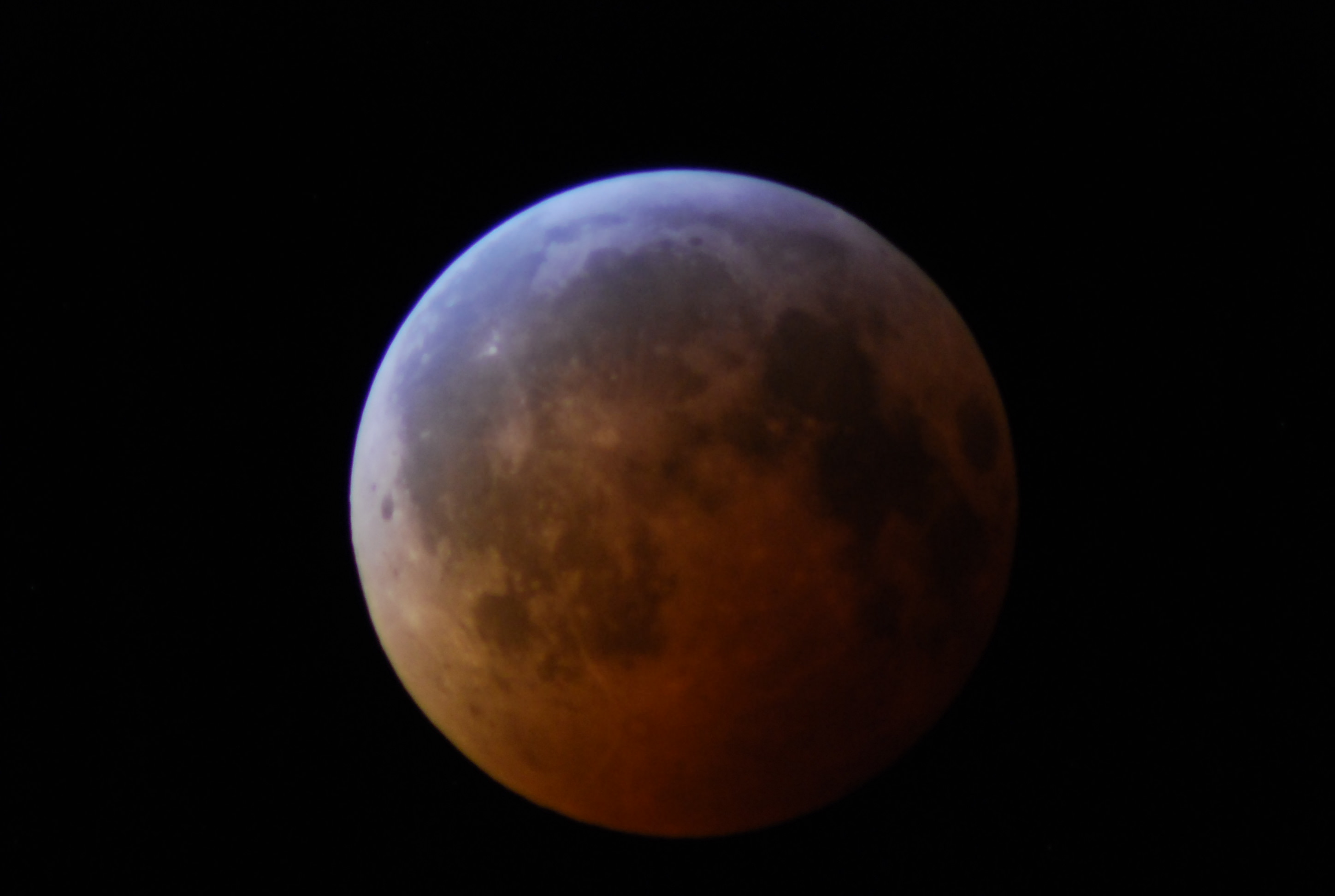
The upcoming lunar eclipse on April 15th is member 56 of Saros 122. I was camping in the Everglades for member 55 on April 3, 1996. Yes, I am that big of a nerd to know that. The totally eclipsed Moon rose in the east as Comet Hyakutake filled a large portion of the sky with its glorious tail. And yes, it was as awesome as it sounds!
That’s awesome… I forgot that Hyakutake was indeed visible during the last eclipse in this saros, thanks for mentioning!